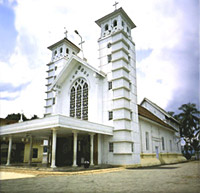 Kottayam, located in the southern part of Kerala is an important commercial centre of India, producing a large chunk of cash crops. A beautiful town situated in the hills, most of India`s natural rubber originates from the acres of well-kept plantations of Kottayam.
The town is also home to the Rubber Board, one of the country`s Primary Commodities Board. Situated in the `Backwater` circuit, the populace of Kottayam is marked by the presence of the Syrian Christian community.
Kottayam, located in the southern part of Kerala is an important commercial centre of India, producing a large chunk of cash crops. A beautiful town situated in the hills, most of India`s natural rubber originates from the acres of well-kept plantations of Kottayam.
The town is also home to the Rubber Board, one of the country`s Primary Commodities Board. Situated in the `Backwater` circuit, the populace of Kottayam is marked by the presence of the Syrian Christian community.
Well known for its churches, Kottayam sandwiched between serene palm-fringed backwaters on the west and the Western Ghats on the east, provides some of Kerala`s finest natural scenes.
Bharananganam
Bharananganam is an important Christian Pilgrimage centre, located 5 kms east of Palai on the Kottayam - Erattupett Road.
Associated with Sister Alphonsa, the blessed saint of the Catholics, the mortal remains of the saint are preserved in a chapel next to the St. Mary`s Church. She lived from 1916 AD to 1946 AD.
 The day of 28th July, the death anniversary of the saint is observed with much solemnity. This 100-year-old church features an attractive grotto of Virgin Mary.
The day of 28th July, the death anniversary of the saint is observed with much solemnity. This 100-year-old church features an attractive grotto of Virgin Mary.
Valiyapalli Church
The St. Mary`s Church, located 2 kms from Kottayam was built as early as 1550 AD. The church is famous for its Persian stone cross, engraved with ancient inscriptions.
The church was built by the descendants of the Syrian Kanaya Christians who migrated to India in 345 A.D., from Jerusalem and near-by places under the leadership of Kana Thoma.
The Valliyapalli Church is famous for its two granite crosses known as Persian Crosses, which were brought to their present location from a much older church near Crangannore, built by the forefathers of the builders of this church.
On each of the stone slabs there is a cross with an inscription in the Pahalavi language, which was the official language of the Sassanian dynasty in Persia.
The smaller slab is placed on the northern altar while the bigger slab lies on the southern altar of the church.
 Cheryapalli
Cheryapalli
Located near the Valia Palli, the smaller church of Cheria Palli, also dedicated to St. Mary, built in 1579, has some Murals and paintings of Biblical and other themes.
Mannanam
Housing the famous St. Joseph`s Monastery, Mannanam is an important Syrian Christian centre. The town is assosiated with the name of Father Kuriakose Elias of Chavara (1805 - 1871), one of the saintly figures of the Syrian Catholic Church of Kerala. Established in 1844, St. Joseph`s Press is one of the oldest printing presses in India, where one of the oldest of Kerala`s newspapers was printed.
Thirunakkara Mahadev Temple
The temple built in the indegenous style is situated in tht heart of the town of Kottayam. It features several murals and is thronged by a large number of devotees during the annual festival held in the third week of March.
Best Time :
August To March



















